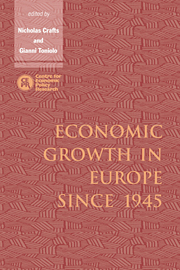Book contents
- Frontmatter
- Contents
- List of figures
- List of tables
- Preface
- List of contributors
- 1 Postwar growth: an overview
- 2 Institutions and economic growth: Europe after World War II
- 3 The varieties of Eurosclerosis: the rise and decline of nations since 1982
- 4 Why the 1950s and not the 1920s? Olsonian and non-Olsonian interpretations of two decades of German economic history
- 5 Convergence, competitiveness and the exchange rate
- 6 British economic growth since 1945: relative economic decline … and renaissance?
- 7 Economic growth in postwar Belgium
- 8 France, 1945–92
- 9 Economic growth and the Swedish model
- 10 Characteristics of economic growth in the Netherlands during the postwar period
- 11 Portuguese postwar growth: a global approach
- 12 Growth and macroeconomic performance in Spain, 1939–93
- 13 Irish economic growth, 1945–88
- 14 Italy
- 15 West German growth and institutions, 1945–90
- 16 An exercise in futility: East German economic growth and decline, 1945–89
- 17 Postwar growth of the Danish economy
- 18 Reflections on the country studies
- Index
8 - France, 1945–92
Published online by Cambridge University Press: 04 August 2010
- Frontmatter
- Contents
- List of figures
- List of tables
- Preface
- List of contributors
- 1 Postwar growth: an overview
- 2 Institutions and economic growth: Europe after World War II
- 3 The varieties of Eurosclerosis: the rise and decline of nations since 1982
- 4 Why the 1950s and not the 1920s? Olsonian and non-Olsonian interpretations of two decades of German economic history
- 5 Convergence, competitiveness and the exchange rate
- 6 British economic growth since 1945: relative economic decline … and renaissance?
- 7 Economic growth in postwar Belgium
- 8 France, 1945–92
- 9 Economic growth and the Swedish model
- 10 Characteristics of economic growth in the Netherlands during the postwar period
- 11 Portuguese postwar growth: a global approach
- 12 Growth and macroeconomic performance in Spain, 1939–93
- 13 Irish economic growth, 1945–88
- 14 Italy
- 15 West German growth and institutions, 1945–90
- 16 An exercise in futility: East German economic growth and decline, 1945–89
- 17 Postwar growth of the Danish economy
- 18 Reflections on the country studies
- Index
Summary
Introduction
France has managed to deliver one of the fastest and smoothest European growth performances since 1950. Why that is so remains largely a matter of debate. Alternative explanations centre on catching-up (Carré et al, 1972; Dubois, 1985), on new personnel at the helm of the state (Sautter, 1982), and on the benefit from opening up to international trade (Adams, 1989). In revisiting French growth we exploit the advantage of hindsight, extending the period of observation to the 1980s and early 1990s, and explore some of the implications of the ‘new’ growth theory emphasizing aggregate increasing returns. This leads us to look at human capital accumulation and the role of institutions.
By 1958, France had not quite exploited all of its potential for catch-up. Its growth performance was impressive in the 1960s, but since 1973 it has undergone the same slowdown as most other European countries. In searching for explanations, like Carré et al. (1972) – the landmark work on French growth – we devote particular attention to industry-level data and emphasize the key role played by the state as part of its traditionally active industrial policies. Like Villa (1993), we note the important role of equipment age and vintage.
As we focus on institutions, we pay particular attention to income distribution and find that the large swings in the rate of investment are well correlated with the share of GDP allocated to profits. More than previous authors, perhaps, we find many footprints of distortionary policies, mainly in the distribution of saving for physical capital accumulation and in the education system for human capital accumulation.
- Type
- Chapter
- Information
- Economic Growth in Europe since 1945 , pp. 210 - 239Publisher: Cambridge University PressPrint publication year: 1996
- 6
- Cited by



